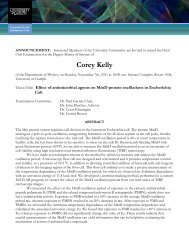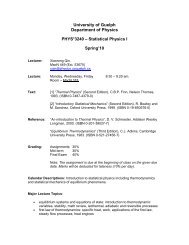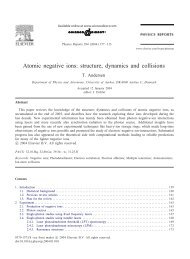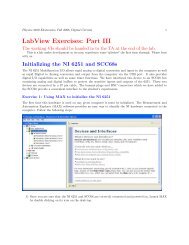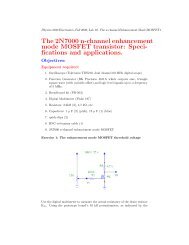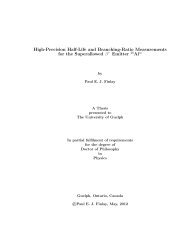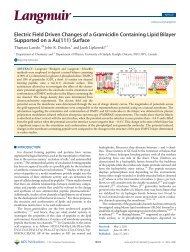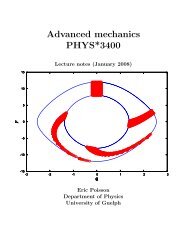Geant4 Simulations for the Radon Electric Dipole Moment Search at
Geant4 Simulations for the Radon Electric Dipole Moment Search at
Geant4 Simulations for the Radon Electric Dipole Moment Search at
Create successful ePaper yourself
Turn your PDF publications into a flip-book with our unique Google optimized e-Paper software.
anaverageof120kHzphotopeakcountr<strong>at</strong>eispossible. Thus, <strong>for</strong>100daysofcounting<br />
we would expect approxim<strong>at</strong>ely N = 1 × 10 12 photopeak counts, with negligable<br />
background when g<strong>at</strong>ed on <strong>the</strong> γ-ray photopeaks. Studies with 209 Rn <strong>at</strong> Stony Brook<br />
[32]havedemonstr<strong>at</strong>ed30seconds<strong>for</strong><strong>the</strong>spin-decoherence time, andavalueof0.2<strong>for</strong><br />
<strong>the</strong>analyzingpower istypical <strong>for</strong>γ-rayanisotropies. Withanelectric fieldof5kV/cm<br />
we calcul<strong>at</strong>e <strong>the</strong> sensitivity <strong>for</strong> <strong>the</strong> EDM measurement (σ d ) to be approxim<strong>at</strong>ely<br />
1×10 −26 e-cmusing <strong>the</strong>γ-rayanisotropytechnique. For<strong>the</strong>β asymmetry method, we<br />
expect larger backgrounds, B ≈ 0.2, but a significantly higher count-r<strong>at</strong>e capability.<br />
Thecount r<strong>at</strong>ein<strong>the</strong>β detectorswillonlybelimitedby<strong>the</strong>decay r<strong>at</strong>eof<strong>the</strong>available<br />
number ofradonnuclei, allowing <strong>at</strong>otaldetected count r<strong>at</strong>eo<strong>for</strong>der 5MHz. AnEDM<br />
sensitivity of 2×10 −27 e-cm is thus expected <strong>for</strong> 100 days of counting using <strong>the</strong> betaasymmetry<br />
technique [32].<br />
These estim<strong>at</strong>es are st<strong>at</strong>istical limits and do not account <strong>for</strong> <strong>the</strong> realistic sources<br />
of backgrounds in <strong>the</strong> actual γ-ray experiment caused by bremsstrahlung production<br />
from <strong>the</strong> stopping β-particles and Compton sc<strong>at</strong>tering of photons both into and out<br />
of <strong>the</strong> γ-ray detectors which can lead to backgrounds underne<strong>at</strong>h <strong>the</strong> γ-ray photopeaks<br />
with different angular distributions than <strong>the</strong> γ-rays of interest. The detailed<br />
simul<strong>at</strong>ions presented in this <strong>the</strong>sis are motiv<strong>at</strong>ed by <strong>the</strong> need to study <strong>the</strong> realistic<br />
signal <strong>for</strong> <strong>the</strong> precession frequencies th<strong>at</strong> will ultim<strong>at</strong>ely determine <strong>the</strong> sensitivity of<br />
<strong>the</strong> RnEDM measurement using <strong>the</strong> γ-ray anisotropy technique (see Chapter 3).<br />
2.4 GRIFFIN Spectrometer<br />
To observe <strong>the</strong> γ radi<strong>at</strong>ion in <strong>the</strong> RnEDM experiment <strong>the</strong> recently funded GRIF-<br />
FIN spectrometer will be utilized. GRIFFIN stands <strong>for</strong> Gamma-Ray Infrastructure<br />
27



